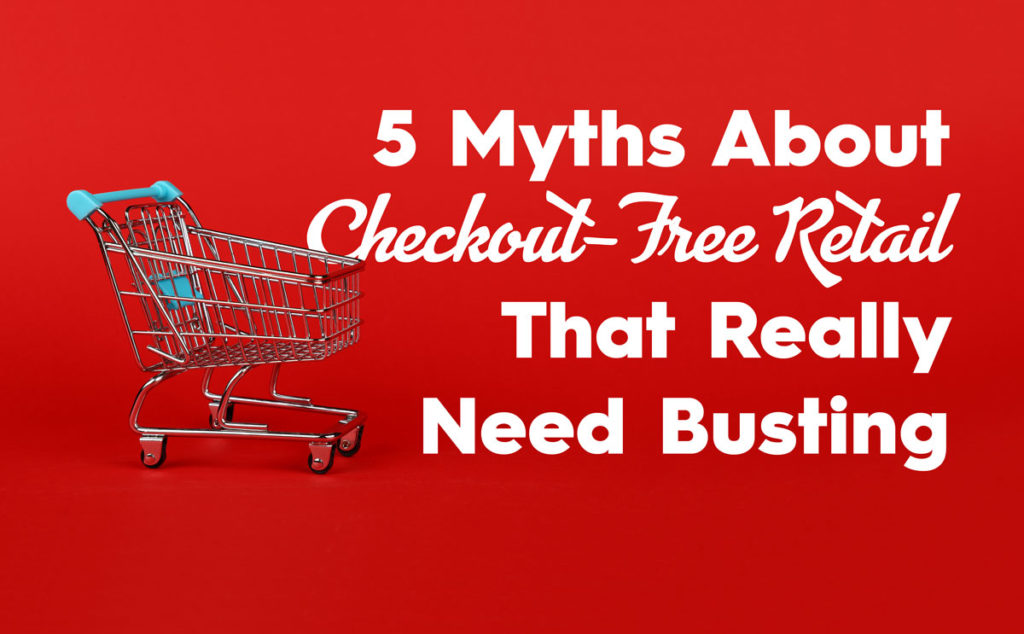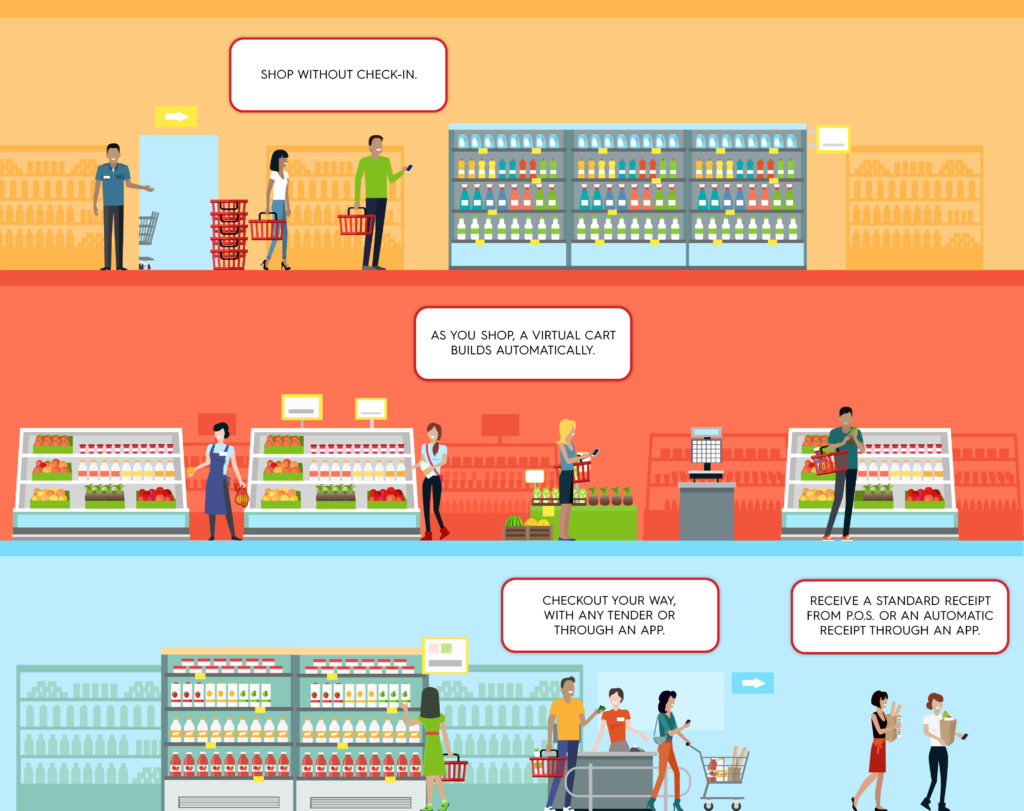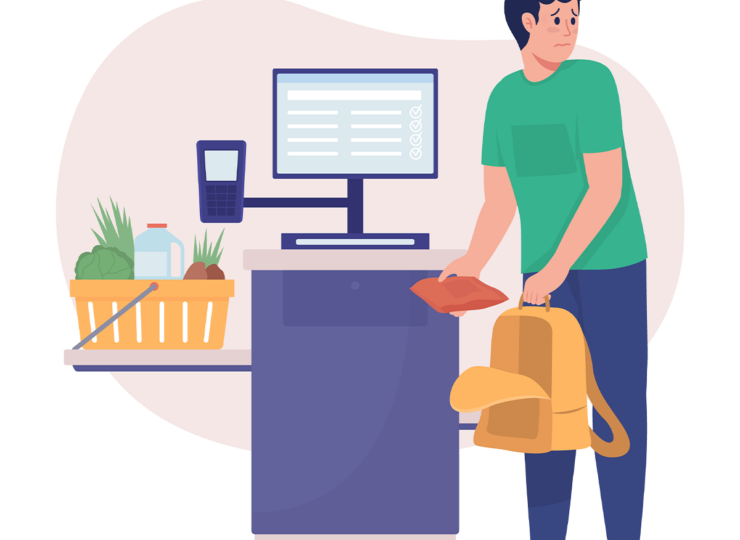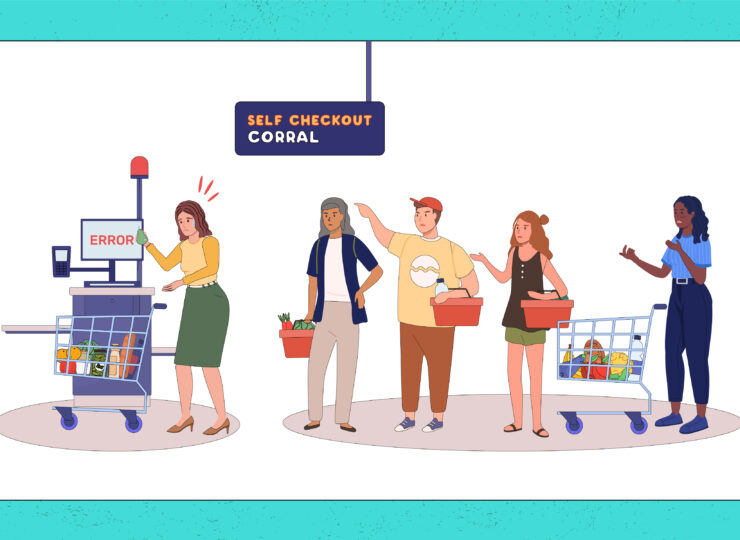5 Myths About Checkout-Free Retail That Really Need Busting

Checkout-free retail is the talk of the town. Ever since Amazon Go burst onto the scene in early 2018, the heat index on the topic has steadily risen. Frankly, there is so much noise out there, it can be difficult to know what to make of it all.
On the one hand, you have a bunch of startups with cool sounding names vying for airtime, and, on the other, you have well-established companies enthusiastically rushing to experiment with the concept. Moreover, scroll through LinkedIn on just about any day of the week, and you will find that dismissing the technology appears to be an old-line retail curmudgeon’s greatest delight.
But there is no denying it. You can mark it down now. Checkout-free retail is coming.
As Anil Aggarwal, CEO of the upcoming Groceryshop conference, is fond of saying, “It’s human nature to overestimate the change that should happen in the short-term and to underestimate the change that will happen in the long-term.” Or, said another way, now is not the time to put technologies down or to get overly excited about them either, but to chart a course of pragmatism.
We are only at the start of the innovation curve related to checkout-free retail.
So, it is time to set the record straight. It is time to put aside the myths propagated by both those that fear change and those that want it to happen too quickly. It is time to bust the myths that do nothing but hold back rationale progress when it comes to checkout-free retail.
The five myths that absolutely need busting are:
Myth #1 – Checkout-Free Technology Only Works in Small Retail Footprints
“Checkout-free technology will never work at a larger scale,” is a favorite saying of detractors, but one that is also not helped by some of the overzealous enthusiasts for the space either. What the detractors and the enthusiasts both forget sometimes is that Amazon Go and its small footprint, roughly 1,500 to 3,000 square feet, acts as a cognitive flag in the ground for the industry’s perception of how the technology can and should work.
While Amazon deserves a ton of credit, we must not forget that Amazon was simply the first to homestead the frontier. How the land gets developed over time is still very much up for grabs.
Seeing the energy around Amazon Go, many startups have rushed to claim whatever slices of the checkout-free frontier they can, whether with standalone small, convenience-style boxes or even their own branded versions of micro-stores with funny sounding names. All of which define retail experiences by the current limitations of checkout-free technology itself, instead of asking how they can take what they know of the technology and adapt it to accommodate larger-sized operations, with fail-safe redundancies and high reliability.
The amazing irony is, that as we examine the next myth, we discover many of the tools required to accommodate checkout-free retail at scale are already built into existing retail operations.
Myth #2 – All Checkout-Free Retail Acts and Works Like Amazon Go
This myth is the most important myth to bust of all. It is what frees our minds to think about checkout-free technology in both larger sized boxes, as well as in entirely new retail frameworks.
The real world is nuanced. Retailers don’t have to choose between checkout-free or not checkout-free, as defined by Amazon Go. The whole relationship is a false dichotomy. Hybrid automated checkout solutions exist and can be just as effective, if not more so, in the long-run and across a wider degree of use cases.
Why?

Because hybrid automated solutions (like those shown above) are congruent with the principles of experience design and work inside of the shopping experiences that people already know. People are creatures of habit, so systems that allow people to opt-into experiences vs. forcing them into experiences they have never before seen are easier on the mind.
For example, there is still much to like about a grocery shopping experience – the smells, the discovery of new products, and even the convenience grocery stores offer for larger sized trips.
But, unfortunately, Amazon Go-style checkout-free systems limit the shopping experience when it comes to these factors. They not only limit the browse and discovery aspects of grocery shopping, but they also introduce friction when it comes to how easily people can get their larger sized baskets home with them. Checking out in a grocery store is a way to pay, yes, but what is often forgotten is that it is also a way to ensure one’s items are bagged conveniently and efficiently too.
Hybrid automated checkout solutions like, for instance, Grabango’s Checkout-Ready solution, work differently. They blend automation with human service design according to the needs of the retailer. They allow retailers to lever up what still should be a core differentiator for physical retail experiences – human interaction and service.
Hybrid solutions also give customers the ability to choose how they want to shop as well. Consumers cannot do this with Amazon Go. Everyone has to shop the same way. But, in hybrid solutions, in-store experiences can be tailored to trip type.
For quick trips, people can walk in and walk out, similar to Amazon Go. For larger sized trips that are damn near an impossibility with Amazon Go, they can still walk up to a designated area to bag their products and pay faster than ever before. And, if they just want to indulge in grocery shopping the old-fashioned way, they can do that too.
All this approach takes is a willingness to design an entire experience fresh from the ground up, with these principles in mind, and to look at computer vision-based checkout-free technology not as a limiting factor in how people can shop but as a solution that should work inside of a greater context.
Myth #3 – All Checkout-Free Experiences Require an App Download
The app myth is the myth most often heard at tradeshow cocktail parties. It is the one that always comes from the too-smart-for-his-own-good dude who says, in a high-pitched sarcastic voice, “But consumers don’t want to download another app!”
This point is so moot.
Whether consumers want to download an app or not is immaterial. Again, as we illustrated above, consumers can decide for themselves how they want to shop and what apps they want to download within the right experience design.
Hybrid automated systems are now available that can track customers anonymously through a store and total up their bills at pay stations quickly and efficiently without any barcode scanning required. The customer simply pays with whatever form of tender he or she chooses, including cash. No app is required. It is just a faster checkout and payment process for the customer.
The best part?
Over time the customers who see other people or (even worse) their friends and family just start to walk in, walk out, and bypass traditional payment points in a store, all will eventually download a retailer’s app too.
Why?
Because psychologically they will feel left out and, at that point, the app download won’t even be a hurdle anymore. Line envy, or shopper envy as others call it, will be so pervasive that it might even put a few Baby Boomers on therapists’ couches the world over.
Think I am crazy? Just ask Starbucks how their mobile app downloads are going. It’s the same phenomenon. And, even if I am crazy, the customer still does not have to choose one way of shopping over the other!
It’s a win-win all around.
Regardless, the natural shopping experience remains intact, which means better economics surrounding adoption and implementation, and consumers can still control the degree of privacy within their shopping experience too.
Hybrid automated systems mean 100% adoption right from the get-go for all consumers. Opt-in. Opt-out. It doesn’t matter.
It’s hard not to love that!
Myth #4 – There’s No ROI in Checkout-Free Retail
Myth #4 is the point that always brings out a chuckle as well. For any technology to work, it must have an ROI. It must be deployed at the right cost, with the right degree of reliability in its componentry. It would be asinine to think that checkout-free retail will ever reach scale if these requirements are not met.
But, even with that said, cognitively it is also important to flip the script within the ROI discussion. Retailers shouldn’t be too focused on what checkout-free systems cost. The far more important question is — what can they make from the concept? It is the numerator, not the denominator, that should demand the most attention, i.e. the return, not the cost. Too often, retailers don’t think in these terms though.
The numbers on the return side of the equation are so powerful that it is almost ludicrous that retailers have not been experimenting with checkout-free retail even faster than they are.
Just look at the figures.
Inventory theft alone represents 100 bps of bottom-line profit per year. Then you add in reductions in shrink, streamlined operations, better in stocks for customers, and conservatively the annualized bottom line benefit gets up into the 300 to 400 bps range rather quickly. Even if you come up short of these goals, these are still huge numbers, especially in grocery retailing.
All of which, intentionally too, says nothing of payroll savings either – my fifth and final point.
Myth #5 – Checkout-Free Retail is Cashier-Less Retail
The beauty of a hybrid automated checkout experience approach is that retailers by way of what their consumers demand can decide how cashier-free or how cashier-plenty they want their future retail experiences to be.
If their business models are about low prices, no frills, no service, then sure, those types of operations may not need as many cashiers, but many retailers’ operations and business models are not designed that way. Human interactions are a key piece of many established retail experience designs. What hybrid automated solutions enable is the ability to funnel the savings from the areas mentioned above back into the service design elements of the store. They allow retailers to funnel money back into why people come to a store in the first place – for inspiration, for touch and feel, for help and guidance, and for the sheer social experience of being out in the world with other people.
No one wants to stand in line, anywhere. Period. But, stopping there is not the point. It comes up short.
Eliminating lines and reducing wait times are important, but the real points of long-run differentiation will be uncovered by the retailers who best expand upon and reinvest in the elements of a physical retail experience that separate it from e-commerce.
Physical retail has and always will be about how the intersection of human, physical, and digital design choices come together within spaces. The beauty of hybrid automated checkout-free experience design is that it allows retailers to dial up or dial down each of these dimensions according to their own business models and to play to their strengths.
The checkout-free pennant race is in early innings, but hybrid design approaches stand out. Hybrid design gives retailers the levers to customize a cocktail of human, physical and digital design elements that fit their brand strategies. And of course, it’s more than just checkout as value is created throughout the shopper journey and at a lower cost. This is the real frontier upon which retailers should stake their claims. The vanquished will be those that seek utilitarian, impersonal physical retail experiences in small footprints with funny names that serve as nothing more than a race to the bottom for anyone not named Amazon.

About the Author
Chris Walton is a leading expert and influencer in omnichannel retailing. An accomplished Senior Executive, with nearly 20 years of success within the retail and retail technology industries, Chris has high-level executive experience across nearly every discipline within retail. Currently, he is the CEO and Founder of Omni Talk, one of the fastest growing blogs in retail, and Third Haus, a retail technology lab and joint venture with Xenia Retail out of Minneapolis. He is a regular keynote speaker, a contributor for Forbes and the Robin Report, and he also sits on the Advisory Board for Delivery Solutions and Xenia Retail. Prior to starting Red Archer Retail and Omni Talk, Chris worked for Target, where he was the Vice President of the retailer’s Store of the Future project and also the Vice President of Merchandising for Home Furnishings on Target.com. Chris began his career at Gap, Inc. and holds a BA in Economics and History from Stanford University, and an MBA from the Harvard Business School.


